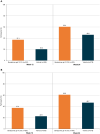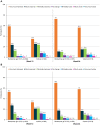A Patient-Centered Perspective of Molluscum Contagiosum as Reported by B-SIMPLE4 Clinical Trial Patients and Caregivers: Global Impression of Change and Exit Interview Substudy Results
- PMID: 36287306
- PMCID: PMC9870829
- DOI: 10.1007/s40257-022-00733-9
A Patient-Centered Perspective of Molluscum Contagiosum as Reported by B-SIMPLE4 Clinical Trial Patients and Caregivers: Global Impression of Change and Exit Interview Substudy Results
Abstract
Background: Molluscum contagiosum is often characterized by persistent lesions and bothersome symptomology. What patients with molluscum contagiosum and/or caregivers consider to be meaningful measures of therapeutic success is unknown.
Objective: We aimed to collect patient experience data and assess Global Impression of Change from patients and/or caregivers participating in a large phase III molluscum contagiosum interventional trial.
Methods: The Berdazimer Sodium In Molluscum Patients with LEsions (B-SIMPLE4) phase III study enrolled 891 patients with molluscum contagiosum. Patients were randomly assigned to berdazimer gel, 10.3% or vehicle gel applied once daily for 12 weeks. Assessments of participant and investigator perceptions of complete lesion clearance were collected at weeks 12 and 24 along with Global Impression of Change scores from 1 (very much improved) to 7 (very much worse). A subset of 30 B-SIMPLE4 patients participated in the patient/caregiver experience exit interview to evaluate bothersome signs and symptoms.
Results: At week 12, among participants with a ≥ 75% molluscum contagiosum lesion count reduction from baseline (as assessed by investigators), 99% (373/376) reported improvement. Perceptions of complete clearance at week 12 were nearly 40% for both participant-reported and investigator-reported Global Impression of Change in berdazimer group vs 20% in the vehicle group: 82% (322/392) of participants in the berdazimer group and 60% (237/394) in the vehicle group reported their molluscum contagiosum lesions were either very much improved or much improved at week 12. Similarly, investigators scored 80% (314/393) of berdazimer and 54% (215/396) of vehicle participants as very much improved or much improved. From the exit interview, the mean duration of participant-reported molluscum contagiosum was nearly 2 years. The most frequently reported molluscum contagiosum-related signs and symptoms were itch (n = 20), scarring (n = 18), and pain (n = 13). Visibility and contagiousness of molluscum contagiosum were the most bothersome aspects to participants. The most frequently reported psychosocial impacts were self-consciousness (n = 15) and embarrassment (n = 14). Lesion clearance was an expectation of 28/30 study participants. Overall, 26/30 reported being very satisfied (n = 18) or satisfied (n = 8) with the changes in their disease over the duration of the trial; 23/30 stated that the change in lesion count was meaningful. A mean reduction of 18 lesions (76% decrease) from the baseline lesion count was reported by participants (n = 28). Although 22 of 28 had less than complete lesion clearance, 17 of 22 reported that the reduction in the number of lesions was meaningful.
Conclusions: Molluscum contagiosum lesion reductions, with or without complete clearance, may be considered a therapeutic "success" by the patient/caregiver.
Clinical trial registration: NCT04535531 (registered 2 September, 2020).
© 2022. The Author(s).
Conflict of interest statement
John Caleb Browning and Ira Thorla Jr were study investigators and are compensated (i.e., honoraria, personal fees) advisors to Novan, Inc. Martina Cartwright and Tomoko Maeda-Chubachi are employees of and stockholders in Novan, Inc. Oyebimpe Olayinka-Amao and Susan A. Martin are employees of RTI Health Solutions, which received funding to conduct the qualitative research and manuscript development. Martina Cartwright was employed by Cassiopea Inc. at the time the study was conducted.
Figures



Similar articles
-
Efficacy and Safety of Topical Nitric Oxide-Releasing Berdazimer Gel in Patients With Molluscum Contagiosum: A Phase 3 Randomized Clinical Trial.JAMA Dermatol. 2022 Aug 1;158(8):871-878. doi: 10.1001/jamadermatol.2022.2721. JAMA Dermatol. 2022. PMID: 35830173 Free PMC article. Clinical Trial.
-
Berdazimer gel for molluscum contagiosum: An integrated analysis of 3 randomized controlled trials.J Am Acad Dermatol. 2024 Feb;90(2):299-308. doi: 10.1016/j.jaad.2023.09.066. Epub 2023 Oct 5. J Am Acad Dermatol. 2024. PMID: 37804936
-
Berdazimer gel for molluscum contagiosum in patients with atopic dermatitis.Pediatr Dermatol. 2024 May-Jun;41(3):438-444. doi: 10.1111/pde.15575. Epub 2024 Feb 27. Pediatr Dermatol. 2024. PMID: 38413239 Clinical Trial.
-
Efficacy and Safety of Topical Cantharidin Treatment for Molluscum Contagiosum and Warts: A Systematic Review.Am J Clin Dermatol. 2018 Dec;19(6):791-803. doi: 10.1007/s40257-018-0375-4. Am J Clin Dermatol. 2018. PMID: 30097988
-
Berdazimer Topical Gel, 10.3%: First Approval.Drugs. 2024 Mar;84(3):363-368. doi: 10.1007/s40265-024-02012-9. Drugs. 2024. PMID: 38409574 Review.
Cited by
-
Molluscum contagiosum survey - common approach and attitude towards treatment and research in Dutch general practice.BMC Prim Care. 2023 Dec 7;24(1):264. doi: 10.1186/s12875-023-02226-y. BMC Prim Care. 2023. PMID: 38057771 Free PMC article.
-
Qualitative In-trial Interviews: Methods, Challenges, and Best Practice.Patient. 2025 May;18(3):199-209. doi: 10.1007/s40271-024-00726-2. Epub 2025 Feb 3. Patient. 2025. PMID: 39899208
-
Berdazimer Sodium: A Novel Nitric Oxide-Releasing Drug in Dermatology.Indian Dermatol Online J. 2025 Jan 20;16(2):359-362. doi: 10.4103/idoj.idoj_259_24. eCollection 2025 Mar-Apr. Indian Dermatol Online J. 2025. PMID: 40125066 Free PMC article. No abstract available.
References
-
- Coyner T. Molluscum contagiosum: a review for healthcare providers. Dermatol Nurses Assoc. 2020;12(3):115–120. doi: 10.1097/JDN.0000000000000534. - DOI
Publication types
MeSH terms
Associated data
LinkOut - more resources
Full Text Sources
Medical
Research Materials

